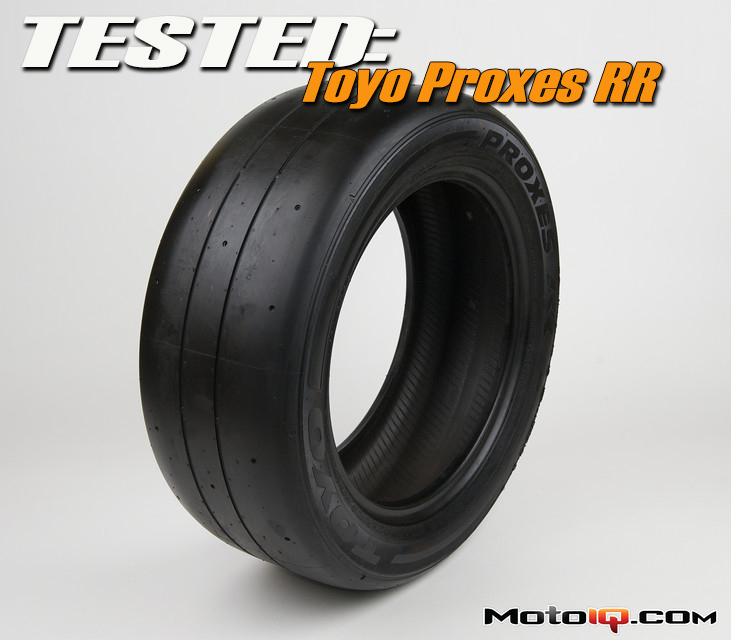,
The Proxes RR’s compound itself is a little softer than the R888 and RA1. While Toyo was mum about compound specifics, the UTQG (which is a relative term for each manufacturer) has been decreased from 100 to 40. The “fingernail test” definitely agrees with this sentiment, as the Proxes RR is noticeably softer than the Proxes RA1 and R888, but not quite as soft as the C71 compound Hankook Z214s or Hoosier A6s most of our competition runs – which are ultra-soft autocross-oriented gumballs.
 Softer than the RA1 and R888, the Proxes RR’s UTQG rating has been reduced to 40. Using the “fingernail test”, it was apparent that the new Proxes RR would be stickier than the RA1s we tested previously. While we knew they would be faster, we wondered if they would prove to last as long.
Softer than the RA1 and R888, the Proxes RR’s UTQG rating has been reduced to 40. Using the “fingernail test”, it was apparent that the new Proxes RR would be stickier than the RA1s we tested previously. While we knew they would be faster, we wondered if they would prove to last as long.The Proxes RR has similar operating temp, pressure, and alignment preferences to the RA1 and R888. Toyo recommends keeping operating temps in the 160-220°F range, meaning a good scrub in will be necessary on cooler days (below 70°F ) before the tire comes alive. Camber settings need to be between -2.5 and -5.0° (pretty much any track-oriented car) and as much caster as possible (within reason). Depending on tire temps across the face of the tire, Toyo recommends hot tire pressures that range from the high 30s to the low 40s, with cold inflation temperatures of no less than 25psi for FWD cars and 18psi for RWD cars. Toyo says that people have run inflation temps as low as 30psi hot and still have consistent grip and wear, but the tradeoff between mechanical grip and rolling resistance falls off the lower you go.
 Internally, the Proxes RR is constructed in a very similar fashion to the RA1 and R888, giving the tire a very familiar feel for us RA1 veterans. This is a very good thing.
Internally, the Proxes RR is constructed in a very similar fashion to the RA1 and R888, giving the tire a very familiar feel for us RA1 veterans. This is a very good thing.Due to the Proxes RR’s unique construction, care must be taken in how you mount them so as not to expose the tire’s tread splice. Toyo recommends mounting the tires in a certain orientation so as not to expose the wrong side of the tread splice to loading from wheelspin. For our FWD G20, we mounted the tires with the DOT date code identifier in (facing the inside of the wheel well) on the left front, and out on the right front, with the opposite configuration on the rear. To maintain this orientation, we rotated the tires in a diagonal direction (RF to LR) throughout the weekend (generally between qualifying and race sessions) and inspected the tire for an exposed tread splice. If at any time the tread splice were to open (not merely be exposed), Toyo recommended we discard and replace the tire. Luckily, this issue never came up, and we never even saw evidence of a tread splice throughout our time with these tires. For more info on recommended mounting, see Toyo’s advisory notice.
 Pay attention to Toyo’s recommended mounting scheme for your vehicle. There are different combinations for FWD, RWD and AWD. Here, the front right tire is mounted with the DOT code facing outwards on our FWD car.
Pay attention to Toyo’s recommended mounting scheme for your vehicle. There are different combinations for FWD, RWD and AWD. Here, the front right tire is mounted with the DOT code facing outwards on our FWD car.Previous experience on our car, with its relatively mild -3.0° of camber and 2500lb weight (with driver), told us we needed to stay on the upper end of the suggested inflation pressures to keep these tires alive. Starting out with 42psi hot, we were a bit surprised to find that the tires could be deflated to about 37-38psi hot up front and 42psi hot out back, making a noticeable improvement in mechanical grip. Oddly enough, however, we did not run higher pressure in the back to maintain handling balance, but because our car was more effectively able to use the rear tires, we were running into outer shoulder wear issues at lower inflation pressures out back. We will shortly (and finally) be addressing our lack of camber issues in a future installment. I’m sure our shocks and kidneys will thank us, as the higher inflation pressures were getting old.
 As you can see, we are still not using enough of the inner tread shoulder due to a lack of negative camber. Stay tuned for a future installment for our remedy.
As you can see, we are still not using enough of the inner tread shoulder due to a lack of negative camber. Stay tuned for a future installment for our remedy.Installation turned out to be a little more difficult than initially thought. Whether it was because we were running taller tires (1” taller), or because the Proxes RRs are wider (0.2”), or both, our first session out we cut a nice chamfer in the outside of the tire with the rear fenders. After an hour of more rather, err, persuasive correction, we were able to get them to fit without rubbing. As stated previously: 245s will require more than a little cutting of the quarter panels to get them to fit. We’ll have to call some flatbiller bros in a future installment to see how we can flare our fenders and quarter panels further.
 With the G20’s miniscule rear fenders for tire clearance, we had to give them a shiatsu massage to get the Proxes RR’s to fit without chamfering the outside corners. Please don’t pay attention to the chipped Bondo, Project G20 has lead a difficult life. Sorry car.
With the G20’s miniscule rear fenders for tire clearance, we had to give them a shiatsu massage to get the Proxes RR’s to fit without chamfering the outside corners. Please don’t pay attention to the chipped Bondo, Project G20 has lead a difficult life. Sorry car.

